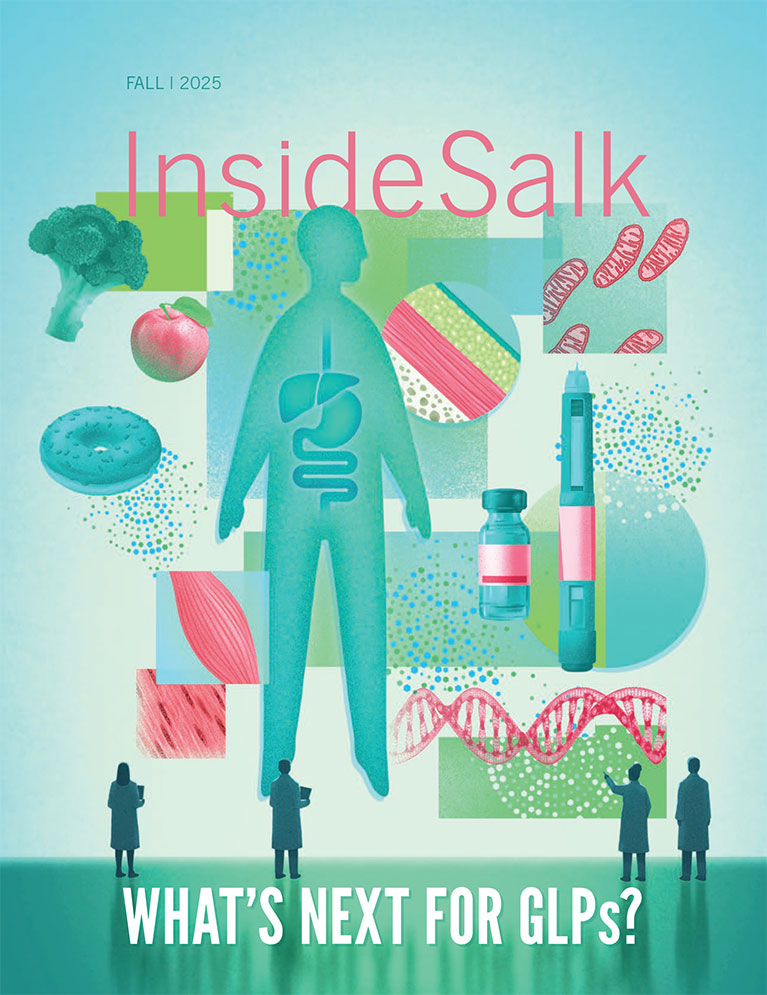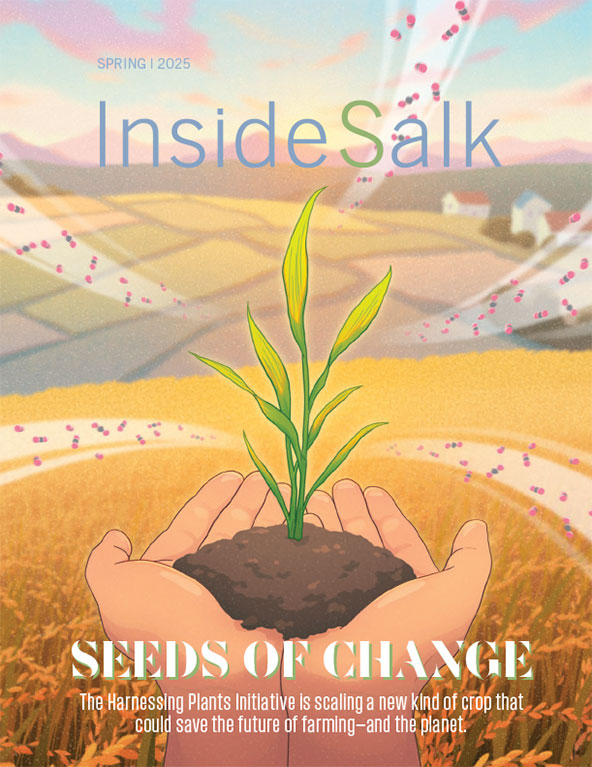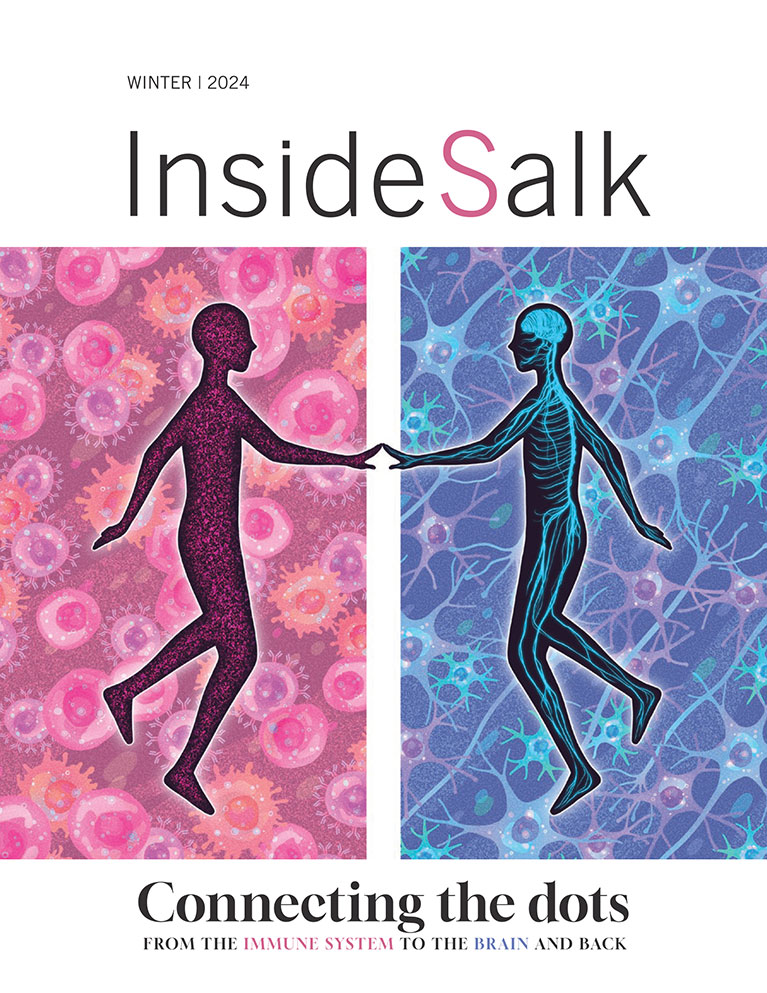Pancreatic cancer has the highest mortality rate of all major cancers. It is especially difficult to treat because the tumors grow so quickly and are constantly evolving. But patient-derived organoids could change all that. In this emerging biotechnology, researchers obtain a small sample from a patient biopsy and use it to grow 3D tissues in the lab. These “organoids” act as miniature models of the patient’s pancreatic tumor and can be used to quickly evaluate which cancer drugs might work best for them. A recent study by Assistant Professor Dannielle Engle, postdoctoral researcher Jan Lumibao, and colleagues provided critical insights into the robustness of patient-derived organoids as a clinical model of pancreatic cancer. They found the organoids’ gene expression and drug responses were not affected by the brand of extracellular matrix used in the cell culture. Data like this increases confidence that clinical conclusions are reliable across different labs and batches of organoids. They also identified one matrix brand that sped up the growth of tumor organoids, making it particularly well-suited for the fast pace of pancreatic cancer treatment protocols.
Read News ReleaseDiscoveries
Artificial intelligence helps scientists engineer plants to fight climate change
The Intergovernmental Panel on Climate Change declared that removing carbon from the atmosphere is now essential to fighting climate change and limiting global temperature rise. In support of these efforts, Salk scientists are harnessing plants’ natural ability to draw carbon dioxide out of the air by optimizing their root systems to store more carbon for a longer period of time. To design these climate-saving plants, scientists in Salk’s Harnessing Plants Initiative are using a sophisticated new research tool called SLEAP—an easy-to-use artificial intelligence (AI) software designed by Salk Fellow Talmo Pereira that tracks multiple features of root growth. Pereira, Professor Wolfgang Busch, bioinformatics analyst Elizabeth Berrigan, and colleagues have officially debuted a new protocol for using SLEAP to analyze plant root phenotypes—how deep and wide they grow, how massive their root systems become, and other physical qualities that, prior to SLEAP, were tedious to measure. Applying SLEAP to plants has already enabled the researchers to establish the most extensive catalog of plant root system phenotypes to date, giving Salk’s Harnessing Plants Initiative a powerful boost.
Read News ReleaseProtecting brain cells with cannabinol
One in 10 individuals above the age of 65 develops an age-related neurological disorder like Alzheimer’s or Parkinson’s, yet treatment options for those patients remain sparse. Scientists have begun exploring whether cannabinoids—compounds derived from the cannabis plant, like well-known THC (tetrahydrocannabinol) and CBD (cannabidiol)—may offer a solution. A third, lesser-known cannabinoid called CBN (cannabinol) has recently piqued the interest of researchers, who have begun exploring the clinical potential of the milder, less psychoactive substance. In a recent study, Research Professor Pamela Maher, postdoctoral researcher Zhibin Liang, and colleagues explained how CBN protects the brain against aging and neurodegeneration, and used their findings to develop potential therapeutics.
Read News ReleaseThis time, it’s personal: Enhancing patient response to cancer immunotherapy
Immunotherapy has revolutionized the way we treat cancer in recent years. Instead of targeting the tumor itself, immunotherapies work by directing patients’ immune systems to attack their tumors more effectively. Still, fewer than half of all cancer patients respond to current immunotherapies, creating an urgent need to identify biomarkers that can predict which patients are most likely to benefit. Associate Professor Diana Hargreaves, postdoctoral researcher Matthew Maxwell, and colleagues have done just that, revealing that mutations in a gene called ARID1A make patients more likely to respond positively to immune checkpoint blockade—a type of immunotherapy that works by keeping cancer-fighting immune cells turned “on.” The ARID1A mutation prompts an antiviral response that pulls more cancer-fighting immune cells into the tumor, and because the gene is present in many cancers—endometrial, ovarian, colon, gastric, liver, and pancreatic—the biomarker could have a huge impact on identifying patients for specific immunotherapies. The findings also encourage the development of drugs that target ARID1A and related proteins as a way of sensitizing other tumors to immunotherapy.
Read News ReleaseUpgrading brain storage: Quantifying how much information our synapses can hold
Recalling each vocabulary word in a flashcard set faster with each flip through is evidence that our neural connections, called synapses, can grow stronger or weaker over time—a feature known as synaptic plasticity. Quantifying the dynamics of individual synapses can be a challenge for neuroscientists, but recent computational innovations from Professor Terrence Sejnowski, postdoctoral researcher Mohammad Samavat, and colleagues are changing that. To understand how the brain learns and retains information, scientists try to quantify how much stronger a synapse has gotten through learning, and how much stronger it can get. Synaptic strength can be measured by looking at the physical characteristics of synapses, but it is much more difficult to measure the precision of plasticity (whether synapses grow weaker or stronger by a consistent amount) and the amount of information a synapse can store. The new computational method can do all three, opening the door for new studies on human learning and memory and how those processes evolve or deteriorate with age or disease.
Read News ReleaseKey nutrients help plants beat the heat
Global temperatures are on the rise, with experts projecting an increase of 2.7°F by 2050. Plants are especially sensitive to these temperature changes. For example, in higher temperatures, plants instruct their root systems to grow faster, creating long roots that stretch through the soil to absorb more water and nutrients. While this response may help the plants in the short term, Professor Wolfgang Busch, postdoctoral researcher Sanghwa Lee, and colleagues have discovered that this ultimately reduces the plant’s levels of two important nutrients—nitrogen and phosphorus—which makes them less nutritious when consumed. At the same time, if the soil contains low amounts of these nutrients, plants return to slower root growth and don’t respond adequately to the higher temperatures. The new molecular details of this interaction between root growth and nutrient availability in the face of high temperatures will inform the engineering of Salk Ideal Plants®—a collection of carbon-capturing, climate change-resilient wheat, rice, corn, and other crops created by Salk’s Harnessing Plants Initiative.
Read News ReleaseUnveiling Telo-seq: A breakthrough in telomere research on aging and cancer
Telomeres—the protective endcaps on our chromosomes—shorten as we age, eventually getting so whittled down that our DNA becomes exposed, and our cells die. However, the specifics of when and how this happens, and whether certain chromosomes are more affected than others, have been unclear—until now. Professor and CSO Jan Karlseder, postdoctoral researcher Tobias Schmidt, and colleagues teamed up with Oxford Nanopore Technologies to develop Telo-seq, a groundbreaking method for determining the precise length and entire sequence of telomeres on each individual human chromosome. They have already used the tool to discover features of telomere biology that were unobservable with previous methods. Telo-seq will facilitate a flurry of new insights into the molecular dynamics of cancer and aging, which will likely inspire future telomere-targeting therapeutics.
Read News ReleaseNeuron identities differ with age and sex
The human brain’s message-sending neurons can behave differently with age. At the root of these changes are shifts in the regulation of neuronal genes—how and when these cellular instructions are read can change the identity of individual neurons. This in turn changes the ratio of different neuronal cell types in the brain. Research Professor Margarita Behrens, Professor Joseph Ecker, Salk colleagues, and collaborators at UC San Diego looked at human frontal cortexes from young adult and aged donors and found widespread age- and sex-related variation in neuronal cell types: both the amount and type of neuronal cells changed with age. Cells in older frontal cortexes expressed fewer genes involved in the active message-sending function of neurons but expressed more subtelomere genes, which help protect the ends of chromosomes from age-related damage. Their findings describe changes in gene regulation in the aging human brain with unprecedented detail. This will ultimately help researchers understand what happens to brain cells in both healthy aging and age-related diseases like Alzheimer’s.
Read News Releaseof the National Academy of Sciences
Salk scientists discover new target for reversible, non-hormonal male birth control
Surveys show most men in the United States are interested in using male contraceptives, yet their options remain limited to condoms or invasive vasectomies. Recent attempts to develop drugs that block sperm production, maturation, or fertilization have had limited success, providing incomplete protection or negative side effects. New approaches to male contraception are needed, but because sperm development is so complex, researchers have struggled to identify parts of the process that can be safely and effectively tinkered with. Now, Professor Ronald Evans, senior staff scientist Michael Downes, staff researcher Suk-Hyon Hong, and colleagues have found a new method of interrupting sperm production that is both non-hormonal and reversible. In a recent study, they demonstrated that treating male mice with an existing class of drugs, called HDAC (histone deacetylase) inhibitors, can interrupt the function of this protein complex and block fertility without affecting libido. The team hopes to see this therapeutic approach advanced to human clinical trials soon.
Read News ReleaseLung cancer hijacks immune cell metabolism to fuel its own growth
Lung adenocarcinoma is the most common lung cancer and the cause of most cancer-related deaths in the United States. There are several ways lung adenocarcinoma can arise, one of which involves a mutation in a protein called EGFR (epidermal growth factor receptor). Modern immunotherapies don’t work against EGFR-driven lung adenocarcinoma, and while other types of lung cancer drugs do exist, patients typically become resistant to them within a few years. Professors Susan Kaech and Christian Metallo, alongside Salk colleagues and collaborators at Yale University and UC Los Angeles, discovered that EGFR-driven lung adenocarcinoma hijacks immune cells called macrophages, pulling them into the tumor and turning them into cancer fuel suppliers. The findings could inspire new lung adenocarcinoma interventions that disrupt this tumor cell-macrophage relationship. They also suggest that treatments using EGFR inhibitors may be more successful when paired with statins, a class of drugs commonly used to lower cholesterol levels.
Read News ReleaseFaulty DNA disposal system causes inflammation
Cells in the human body contain power-generating mitochondria, each with their own mtDNA—a unique set of genetic instructions that mitochondria use to create life-giving energy. When mtDNA remains where it belongs (inside mitochondria), it sustains both mitochondrial and cellular health; when it goes where it doesn’t belong, it can initiate an immune response that promotes inflammation. Now, Professor Gerald Shadel, Salk colleagues, and collaborators at UC San Diego and University of Virginia have discovered a mechanism that expels improperly functioning mtDNA from the mitochondria. When this happens, the mtDNA gets flagged as foreign DNA and activates an inflammatory pathway. This pathway is a promising target for new therapeutics that could disrupt or mitigate inflammation in aging or diseases like lupus or rheumatoid arthritis.
Read News ReleaseMore than just neurons: A new model for studying human brain inflammation
Neurons only make up half of the human brain. The other half is composed of approximately 85 billion cells called glia. The most common type of glial cells are astrocytes, which are important for supporting neuronal health and activity. Despite the abundance of astrocytes in the brain, most existing laboratory models of the human brain fail to include astrocytes at sufficient levels or at all, which limits the models’ utility for studying brain health and disease. Now, Professor Rusty Gage, postdoctoral researchers Lei Zhang and Meiyan Wang, and colleagues have created 3D organoids that mimic features of the human brain and contain mature, functional astrocytes. With this astrocyte-rich model, researchers will be able to study stress and inflammation in aging and Alzheimer’s disease with greater depth and clarity than ever before. Already, the researchers have used the new organoids to reveal a relationship between astrocyte dysfunction and inflammation. This allowed them to identify a potentially druggable target for disrupting that relationship in the aging brain.
Read News ReleaseControlling root growth direction could help save crops and mitigate climate change
Roots are central to a plant’s survival and productivity, determining the plant’s access to nutrients and water and, therefore, its ability to tolerate nutrient depletion and extreme weather, like drought. Professor Wolfgang Busch, postdoctoral researcher Wenrong He, and colleagues recently determined how a well-known plant hormone controls the angle at which roots grow. The study is the first time the plant hormone, called ethylene, has been shown to be involved in regulating the lateral root angles that shape root systems—providing key insights for plant scientists looking to optimize root systems. Researchers in Salk’s Harnessing Plants Initiative now plan to target the ethylene signaling pathway in their efforts to engineer plants and crops that can withstand the environmental stresses of climate change and drought.
Read News Releaseof the National Academy of Sciences
Modeling the origins of life: New evidence for an “RNA World”
Scientists in the 1960s, including Salk Fellow Leslie Orgel, proposed that life began with the “RNA World”—a hypothetical era in which small, stringy RNA molecules ruled the early Earth and established the dynamics of Darwinian evolution. New research by Professor and Salk President Gerald Joyce, research associate Nikolaos Papastavrou, staff scientist David Horning, and colleagues provides fresh insights on the origins of life, presenting compelling evidence supporting the RNA World hypothesis. The recent study unveiled an RNA enzyme that can make accurate copies of other functional RNA strands while allowing new variants of the molecule to emerge over time. These remarkable capabilities suggest the earliest forms of evolution may have occurred on a molecular scale in RNA.
Featured Stories
 Getting to the root of Alzheimer’sSalk scientists are teaming up to understand brain aging. By collaborating across disciplines like genetics, neuroscience, and immunology, our researchers are uniquely positioned to lead us into a future of healthier aging and effective therapeutics for Alzheimer’s.
Getting to the root of Alzheimer’sSalk scientists are teaming up to understand brain aging. By collaborating across disciplines like genetics, neuroscience, and immunology, our researchers are uniquely positioned to lead us into a future of healthier aging and effective therapeutics for Alzheimer’s. Salk mourns the loss of Joan JacobsThe Salk Institute lost one of its greatest supporters and one of San Diego’s most generous philanthropists when Joan Jacobs died on May 6, 2024, in La Jolla, California. She was 91 years old.
Salk mourns the loss of Joan JacobsThe Salk Institute lost one of its greatest supporters and one of San Diego’s most generous philanthropists when Joan Jacobs died on May 6, 2024, in La Jolla, California. She was 91 years old. Axel Nimmerjahn— Widening perspectives through plane windows and microscope lensesInside Salk sat down with Nimmerjahn to hear how he went from curious child to world renowned researcher. Now a professor at Salk, he studies the central nervous system and designs new tools—like mini microscopes!—to study the system's various cell types.
Axel Nimmerjahn— Widening perspectives through plane windows and microscope lensesInside Salk sat down with Nimmerjahn to hear how he went from curious child to world renowned researcher. Now a professor at Salk, he studies the central nervous system and designs new tools—like mini microscopes!—to study the system's various cell types. Jálin Johnson— Enhancing equity and inclusion at Salk and beyondOver the course of nearly 30 years dedicated to advocacy work, Jálin B. Johnson has served those in need and has given a voice to the voiceless—a principle that has guided her throughout her career. This commitment continues to shape her work as she steps into the role of director of Salk’s Office of Equity & Inclusion.
Jálin Johnson— Enhancing equity and inclusion at Salk and beyondOver the course of nearly 30 years dedicated to advocacy work, Jálin B. Johnson has served those in need and has given a voice to the voiceless—a principle that has guided her throughout her career. This commitment continues to shape her work as she steps into the role of director of Salk’s Office of Equity & Inclusion. Lara Labarta-Bajo—An immunologist’s journey from Barcelona and ballet to the brainWhether dancing in Spain or surfing in San Diego, Lara Labarta-Bajo has always celebrated the power of the human body. Now a postdoctoral researcher in Associate Professor Nicola Allen’s lab at Salk, she studies how the immune system connects the body to the brain and how this relationship evolves as we age.
Lara Labarta-Bajo—An immunologist’s journey from Barcelona and ballet to the brainWhether dancing in Spain or surfing in San Diego, Lara Labarta-Bajo has always celebrated the power of the human body. Now a postdoctoral researcher in Associate Professor Nicola Allen’s lab at Salk, she studies how the immune system connects the body to the brain and how this relationship evolves as we age. Professor or partner? Luc Jansen’s switch from science to lawDashed dreams of medical school brought Jansen to Salk's campus back in 2003, where he simultaneously contemplated a career in scientific research and a career in big law. Though he decided on law in the end, Jansen's affection for Salk remains as he now hosts Salk gatherings in his New York City office and excitedly shares the enduring importance of basic science.
Professor or partner? Luc Jansen’s switch from science to lawDashed dreams of medical school brought Jansen to Salk's campus back in 2003, where he simultaneously contemplated a career in scientific research and a career in big law. Though he decided on law in the end, Jansen's affection for Salk remains as he now hosts Salk gatherings in his New York City office and excitedly shares the enduring importance of basic science. Rising Stars and DISCOVER programs provide new opportunities for trainees from underserved backgroundsThe Salk Institute recently hosted two inaugural events designed to enhance diversity within the scientific community: the Rising Stars Symposium and the Diverse Inclusive Scientific Community Offering a Vision for an Ecosystem Reimagined (DISCOVER) Symposium.
Rising Stars and DISCOVER programs provide new opportunities for trainees from underserved backgroundsThe Salk Institute recently hosted two inaugural events designed to enhance diversity within the scientific community: the Rising Stars Symposium and the Diverse Inclusive Scientific Community Offering a Vision for an Ecosystem Reimagined (DISCOVER) Symposium.





















































